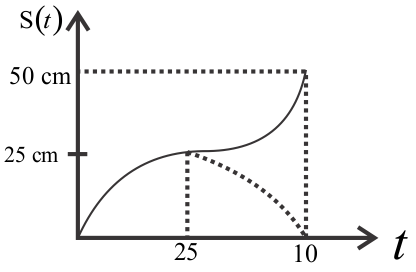Question
Question: At the moment \(t = 0\) a particle leaves the origin and moves in the positive direction of the \(x ...
At the moment t=0 a particle leaves the origin and moves in the positive direction of the x−axis. Its velocity varies with time as υ=υ0(1−t/r), where υ0 is the initial velocity vector whose modulus equalsυ0=10.0cm/s.t=5.0s. Find:
(a) the x coordinate of the particle at the moments of time 6.0,10, and 20s.
(b) the moments when the particles are at the distance 10.0cm from the origin,
(c) the distance s covered by the particle during the first 4.0 and 8.0s, draw the approximate plots(t).
Solution
Hint The meaning of speed of an object is outlined because of the rate of change of the object’s position with relation to a frame of reference and time. It would sound difficult however velocity is largely speeding in a very specific direction. It’s a vector quantity, which implies we'd like each magnitude (speed) and direction to outline velocity.
Complete step by step solution:
(a)As the particles leaving the origin at t=0
So,
⇒△x=x−∫vxdt
Further expanding it,
⇒v=v0(1−τt)
Where
⇒vx=v0(1−τt)
From the above two-equation,
⇒x=∫v0(1−τt)dt=v0t(1−2πt)
Hence X coordinate of the particle at t=6s
⇒x=10×6(1−2×56)
On solving the above, we get
⇒24cm=0.24m
Similarly at t=10s
⇒x=10×10(1−2×510)
⇒0m
Now at t=20s
⇒x=10×20(1−2×520)
Further on solving,
⇒−200cm=−2m
(b). At the moment the particle is at a distance of 10cm from the origin,
⇒x=±10cm
Putting ⇒x=±10cmin the above equation
⇒10=10t(1−10t)
On simplifying
⇒t2−10t+10=0
Now we will find the value of t from here.
⇒t=210±100−40
On simplifying,
⇒5±15s
Now putting x=−10
We get,
⇒−10=10(1−10t)
On solving,
⇒t=5±35s
As t cannot be negative, so
⇒t=5+35s
So the particle is at the following time at three intervals:
t=5+35s,5±15s.
(c). We have
⇒v=v0(1−τt)
So, v=∣v∣=v0(1−τt) for t⩽τ
And
⇒v=∣v∣=v0(τt−1) for t > τ
Therefore,
⇒s=∫0tv0(1−τt)dt For t⩽τ=v0t(1−2πt)
And
⇒v0τ[1+(1−τt)2]/2 for t>τ(A)
Now we will solve the integration,
⇒s=∫04v0(1−τt)dt
Putting the required value, we get
⇒s=∫0410(1−5t)dt
⇒24cm
And for t=8s
⇒s=∫0510(1−5t)dt+∫5810(5t−1)dt
On integrating and simplifying, we get
⇒s=34cm
Based on the above equations. Graph plot can be drawn as shown below

Note: Speed and velocity is a touch confusing for many people. Well, the distinction between speed and velocity is that speed offers us a plan of how briskly an object is moving whereas velocity not solely tells us its speed however additionally tells us the direction the body is taking possession. We can outline speed as a function of distance traveled whereas velocity could be a performance of displacement.
